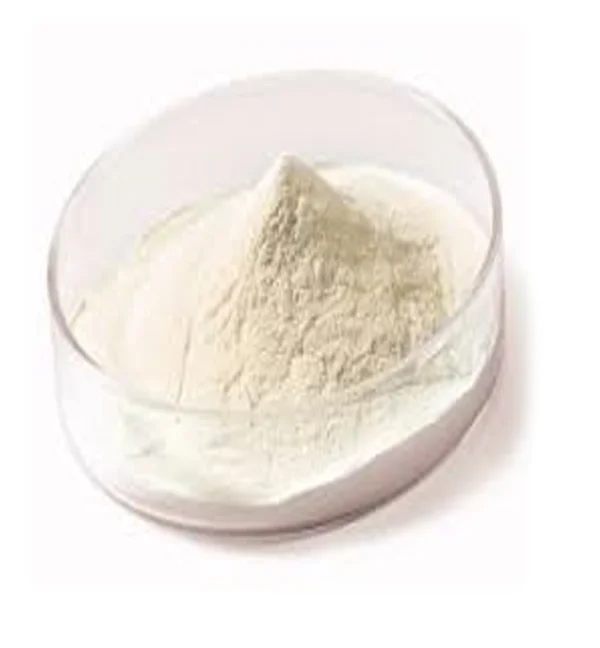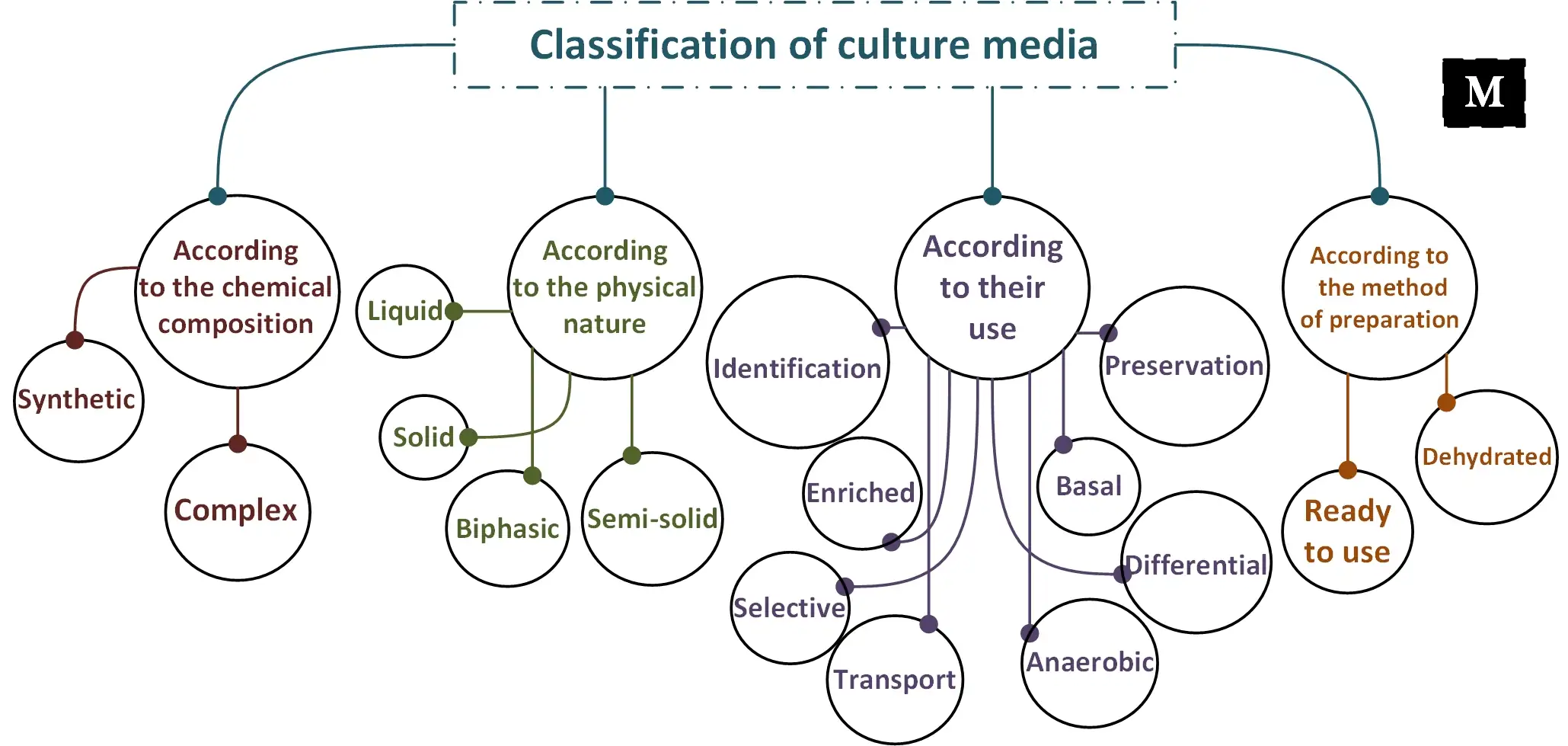☰ Content :
Ⅰ. Introduction
Culture media or growth medium are essential for bacterial multiplication, which subsequently allows the identification as well as the study of sensitivity to antibiotics when the bacterium is isolated in pure culture.
A bacterial culture media is a preparation in which microorganisms can multiply. It must therefore meet the nutritional requirements of the micro-organism studied and possess the physico-chemical properties suitable for this culture:
- Cover the needs in mineral ions, growth factors, provide the source of carbon, energy and nitrogen.
- Present a pH close to the optimal pH, an adequate osmotic pressure and viscosity.
Most of these microbiological growth media are produced by major suppliers of dehydrated media, including Oxoid, HiMedia, BD Diagnostics and Millipore . These include all media normally used in the clinical microbiology diagnostic laboratory and for routine examination of food and water.
Ⅱ. Chemical constituents of culture media
The notion of minimum medium: A minimum medium is a medium containing the chemical elements strictly necessary for bacterial growth, in a form that can be used by bacteria with no particular requirements: a source of carbon and energy, a source of potassium, phosphorus, nitrogen, sulfur, magnesium, calcium, iron, trace elements, water and a pH buffer.
1. Meat extracts:
Meat extracts is prepared from selected animal tissues which give it its excellent nutritiousness.
In association with peptones of different origins, the meat extract constitutes an excellent nutritive supplement intended for the elaboration of various culture media. It is usually incorporated at concentrations ranging from 0.2 to 1.0%.
Example: Bacto dehydrated beef extract, Bacto Beef Heart for Infusion

Meat extracts
2. Peptones
Peptones are mixtures of water-soluble compounds resulting from the action of proteolytic enzymes or acids on proteinaceous materials. They provide the culture medium with amino acids, peptides (source of energy, carbon, nitrogen) mainly.
Casein is most often used as a protein substrate to form peptones, but other substances, such as soy flour, are also commonly used.
Example : Peptonized milk, Proteose Peptone
3. Growth factors
The incorporation of growth factors is used to enrich the culture media to successfully cultivate fastidious microorganisms. Most often, mixtures of growth factors are used in microbiological media:
- Hydrolysates : these are peptones obtained by an inorganic action (Hydrochloric acid) on proteins. Example: Acid hydrolyzate of casein.
-
Yeast extracts : Autolytic yeast extract is considered the main enrichment factor for culture media. It is prepared in the form of a water-soluble extract of autolyzed Saccharomyces cerevisiae yeast cells. During autolysis, endogenous yeast digestive enzymes break down the protein content. Additionally, yeast extract provides an essential source of water-soluble B-complex vitamins, carbohydrates and free glutamic acid.
Due to its carbohydrate content, it should not be used in media intended for the study of sugar fermentations. - Biologic products :Many media, especially those used in the clinical laboratory, contain biologicals that serve as essential nutrients for fastidious microorganisms.
Example : Blood or blood components, eggs, skimmed cow's milk, horse or beef serum.
4. Selective / Differential Components
Selectivity : Culture media may contain selective components that inhibit the growth of non-target microorganisms. These media are particularly used for the isolation of specific microorganisms from mixed populations.
Several techniques are used to make the backgrounds selective :
- By adding a toxic component: bile salts, selenite, high concentrations of chloride.
- By adding antibiotics: cycloheximide, gentamicin, nalidixic acid, vancomycin.
- By using a single source of energy.
Differentiation : Differential media make it possible to distinguish one type of microorganism from another developing on the same medium. they contain compounds that make it possible to visually distinguish groups of microorganisms by the appearance of the colony or the surrounding medium.
- Some media include indicators that allow visual detection of changes following acid production from various carbohydrates and other carbon sources or upon decarboxylation of amino acids.
- Other media include chromogenic dyes which change color when specific enzymatic reactions occur.
5. Agar-agar
It is an extract of red algae (rhodophyceae) belonging to the genera Gelidium and Gracilaria, harvested in the seas of Japan or New Zealand.
Cchemically, agar is a mixture of two groups of polysaccharides, one of which, dominant, is agarose, with little or no sulphate, it has a gelling property.
The agar dissolves in water around 90°C, remains supercooled up to 45°C; then at low temperature, it forms a more or less solid transparent gel depending on its concentration in the water. It is not generally degraded by micro-organisms (except rare bacteria and fungi).
◉ For more information about Agar
Ⅲ Classification of culture media
There is a wide variety of culture media, depending on their chemical composition, physical nature, use or method of preparation, culture media can be classified into several groups

Classification of culture media
🏾. Classification of culture media according to their chemical composition
1. Complex culture medium / undefined
The medium has a known composition only with approximation, the complex medium contains complex ingredients, such as yeast extract or casein hydrolyzate, in unknown proportions.
Example : LB Broth, Columbia Agar ,
Gassner Agar, Tryptycase Soy Agar
2. Synthetic culture medium / defined
Composition exactly known, qualitatively and quantitatively. They are chemically defined media prepared from pure
chemical substances. A synthetic medium is entirely free of animal-derived components (including microbial-derived
components such as yeast extract). These media are very useful for studying the physiology, metabolic nature and nutritional requirements of bacteria.
Example : Simmons citrate agar, mineral glucose medium.
🏾 Classification of culture media according to their physical nature
1. Liquid culture medium
The agar is not added during the preparation of the medium, the growth results in a cloudy, a deposit or a superficial veil. The presence of more than one type of bacteria cannot be detected and mixed cultures cannot be separated.
Exemple : Nutrient broth,
Tryptycase Soy broth
2. Semi-solid culture medium
Containing 0.5-0.75% soft consistency agar, it is used to demonstrate bacterial motility.
Example: Mannitol mobility medium.
3. Solid culture medium
A solid medium is obtained by adding a gelling agent, "agar-agar" or agar, to a liquid medium. It allows the identification of bacteria by studying the characters of the colonies (morphology, pigmentation, haemolysis...) and Mixed cultures can be separated.
Example: Nutrient agar,
Cled agar .
4. Biphasic culture medium
The medium contains both a solid part and a liquid part in a single bottle. The inoculum is added to the liquid medium and when subcultures are to be made the bottle is simply tilted to allow the liquid to flow over the solid medium.
Example: Castaneda medium, Middlebrook Biphasic System (Middlebrook 7H11 Agar Slant + Middlebrook 9H Broth).
🏾 Classification of culture media according to their uses
1. Simple culture medium
Simple, basic culture media are those which can be used for the culture of nonfastidious bacteria. Typically used in routine laboratory diagnostics for the primary isolation of bacteria. This type of medium can be made richer, by adding supplements, or selective, by adding varying concentrations of sodium chloride.
Exemple: Bouillon nutritif, Nutrient agar et peptone water.
2. Enriched culture medium
These media are used to obtain so-called "fastidious" bacteria by adding supplements in the form of blood, serum, egg yolk, etc.
Example: Blood agar.
3. Selective medium and enrichment medium
A selective medium is formulated to inhibit the growth of certain bacterial species. These media can be formulated by adding additional selective reagents, such as high salt concentration to select for halophiles, eosin-methylene blue toxic to Gram-positive bacteria.
Example: EMB agar, MacConkey agar.
An enrichment medium also allows the growth of specific bacterial species, however, enrichment media are supplemented with a reagent that allows, rather than inhibits, the growth of a particular species.
Example: Selenite F broth (selenite is an inhibitor for coliforms and beneficial for the recovery of Salmonella species), Thayer Martin agar.
4. Differential medium
The so-called “differential” or “indicator” culture medium makes it possible to distinguish two types of microorganisms developing in the same medium. This type of medium uses the biochemical characteristics of a microorganism growing in the presence of specific nutrients and/or indicators (such as neutral red or methylene blue) added to the medium to visibly indicate the defining characteristics of a microorganism.
Example: MacConkey agar (By the fermentation of lactose),
Mannitol salt agar (by the fermentation of mannitol).
5. Transport medium
These media are used when specimens cannot be cultured soon after collection. Transport media prevent drying of the sample and inhibit the growth of undesirable bacteria.
Example: Cary-Blair agar, Amies Medium.
6. Anaerobic medium
Anaerobic bacteria need reduced oxidation-reduction potential and additional nutrients. Such media can be reduced by physical or chemical means.
Example: Schaedler anaerobic agar, Wilkins-Chalgren agar.
🏿 Classification of culture media according to the method of preparation
1. Ready-to-use medium
Ready-to-use culture medium is a solid or liquid medium supplied in dishes, bottles, tubes or other containers, in ready-to-use form or ready-to-use after reflow and supplementation.
2. Medium prepared from dehydrated formulations
A culture medium is a medium in dry form that requires rehydration and processing before use, resulting in either a complete medium or an incomplete medium to which supplements are added before use.